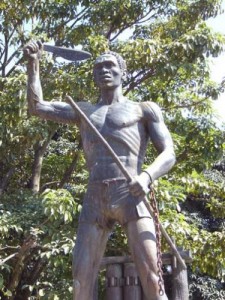by dan on December 31, 2010
American Uprising began as my senior thesis at Harvard; Violent Visions; Slaves, Sugar, and the 1811 German Coast Uprising. I thought I’d share the thesis here online (Click here to download: VIOLENT_VISIONS). I wrote Violent Visions in a different style than American Uprising. I think of it as the google maps version of the story and my book as the google street view version; one is very zoomed out and academic (but hopefully not too dry) the other tries to bring the action to the reader. Both the thesis and the book rely on extensive primary and secondary source research, which I wanted to share more about.
I spent two years researching the revolt in archives in New Orleans, Washington, DC, and Massachusetts, and I compiled an authoritative collection of primary and secondary sources, including many never-before-studied letters and court records. The problem that scholars investigating the 1811 revolt face is that the easy sources – the letters and newspaper accounts – are also the most biased and the most charged with political purpose. The planters and the American officials had a significant incentive to downplay the slaves’ achievements while glorifying their own power and the strength of their reaction. To get the true story, you have to start working with more difficult sources; planter ledgers and wills, runaway advertisements, diplomatic correspondence, court transcripts, and legal records. These sources provide fragmentary information, much of it in list form. For example, a planter ledger might note a slave, the slave’s age, his occupation on the farm, and the cause of death. The court transcript might say something along the lines of; “Robin denounces Quamana as an infamous brigand.” These lists are difficult to process.
To deal with this fragmentary information, I built two Excel databases of information about the slaves that participated in the uprising – their backgrounds, occupations, and physical descriptions. I used these electronic databases to process and understand exactly what had happened and where. I mapped this information onto early 19th century land ownership maps and used tools like Google Maps to figure out how long it would take to get from one place to the other. Slowly but surely, I built out the chronological narrative – when and where slaves had joined the uprising, what they had done and when and where they did it, just who had participated.
What emerged was a story very different from that the planters attempted to write – a story about slave who were able to organize a truly massive insurrection and come very close to succeeding. But to hear more about this, you’ll have to read the book…
by dan on December 26, 2010

A photo of a sculpture of Yanga in Mexico
Sculptor Anne Bouie shared this inspiring sculpture of the Mexican slave rebel and maroon leader Yanga. In the sculpture, Yanga casts off his chains and holds high a knigfe and spear, symbols of violent insurrection. Yanga takes a heroic pose, his eyes staring upwards at the heavens, his feet firmly and defiantly planted. You cannot help but feel inspired by this striking image.
Yet we see few sculptures like this here in the United States. The most popular sculpted images of slaves feature kneeling slaves in chains or slaves being freed from captivity by gracious whites (see Kirk Savage’s excellent book on this topic, Standing Soldiers, Kneeling Slaves). American popular consciousness casts slaves as victims and looks upon slavery as a depressing and guilty part of our nation’s past.
I hope that the first commemorative statues about the 1811 revolt will portray the rebel slaves in the same light as this Yanga sculpture – and in the same light as I try to portray them in my book – as sophisticated and complex, politically aware, heroes who were willing to sacrifice their lives for freedom and equality.
by dan on December 24, 2010
When I first started researching the 1811 revolt, there was almost nothing on the internet on the topic. The bicentennial has brought new found attention to the event, and I wanted to link to some of the great new websites that are sharing the story of the revolt.
As an exercise early on in my research, I decided to write the Wikipedia page for the uprising (shockingly, there was no page on the event in 2009). You can read that page here: http://en.wikipedia.org/wiki/1811_German_Coast_Uprising
A group of Tulane University students working on a service learning project have assembled a great website at www.1811slaverevolt.com. The website provides a comprehensive bibliography of sources as well as a few other extras that should prove a great resource to scholars.
Though the revolt has been forgotten almost everywhere else in the country, a small group of community activists on the German Coast have fought to preserve the stories and memories of the event. The best way to experience this grassroots history and memory-keeping is through Leon Waters’ Hidden History Tours. I encourage anyone visiting New Orleans to take Mr. Waters’ excellent tour of the sites of the 1811 revolt. Find his site here: http://www.historyhidden.net/.
Finally, you can find some of the original court transcripts uploaded online to the Louisiana Digital Library. Find those cases here: http://louisdl.louislibraries.org/cdm4/results.php?CISOOP1=any&CISOBOX1=slave+1811&CISOFIELD1=CISOSEARCHALL&CISOOP2=all&CISOBOX2=slave+insurrections+–+louisiana+–+history+–+19th+century&CISOFIELD2=subjec&CISOROOT=/LSU_CFF,/LPC,/lapur,/LCT,/LPH,/SartainEngravings&t=s.
by dan on December 16, 2010
Thank you for visiting the site for my new book, American Uprising, which is coming out on January 4. Over the next few months, I’ll be using this blog to describe my experiences on my book tour, updating you on the latest media and publicity, and sharing my thoughts on slavery and black history. I hope you’ll enjoy the book and my writing on this website.



